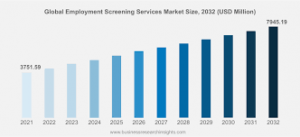The global employment screening services market is on track for substantial expansion, with projections indicating a rise from USD 3.75 billion in 2021 to USD 7.95 billion by 2032, reflecting a compound annual growth rate (CAGR) of 7.06% during the forecast period. These insights are part of a new report from Business Research Insights, which can be found here.
Key Market Drivers
- Technological Integration: The adoption of artificial intelligence (AI) and machine learning is revolutionizing employment screening by enhancing efficiency and accuracy. These technologies facilitate comprehensive background checks and virtual interviews, streamlining the hiring process.
- Remote Work Trends: The COVID-19 pandemic has accelerated the shift towards remote work, increasing the demand for digital screening solutions. Online background checks and virtual interviews have become essential tools for employers navigating the challenges of remote hiring.
- Industry-Specific Needs: Sectors such as healthcare, logistics, and essential services have experienced heightened demand for employment screening services to ensure the quality and suitability of new hires, especially during periods of increased hiring activity.
Challenges Impacting Market Growth
- Economic Downturns: The pandemic-induced economic slowdown led to hiring freezes and layoffs in various industries, resulting in a decreased demand for employment screening services as companies scaled back recruitment efforts.
- Regulatory Compliance: Navigating the complex landscape of employment laws and regulations across different regions poses challenges for service providers and employers, necessitating continuous updates and compliance measures.
Future Outlook
The employment screening services market is expected to rebound as economies recover and hiring activities resume. The ongoing integration of advanced technologies and the adaptation to remote hiring practices are anticipated to drive market growth, offering efficient and reliable screening solutions to meet evolving employer needs.
For a comprehensive analysis, refer to the full report by Business Research Insights.







